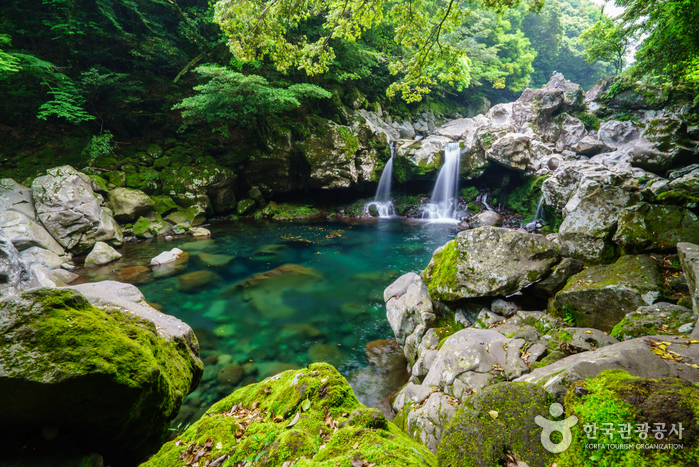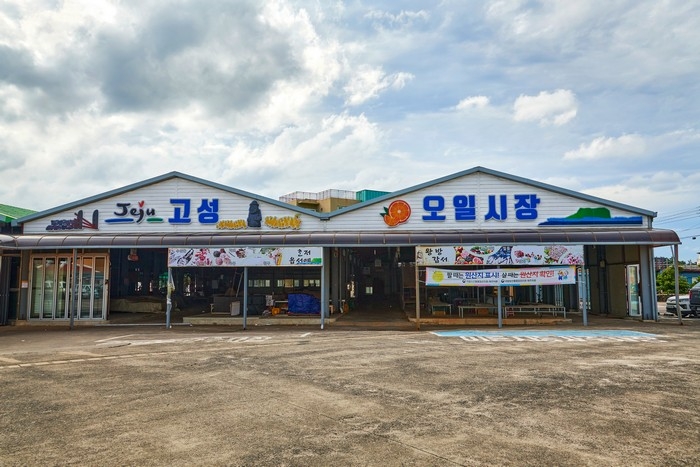Honinji Pond (혼인지)
14.6Km 2022-12-26
39-22, Honinji-ro, Seogwipo-si, Jeju-do
+82-64-710-6798
Honinji Pond is connected to a myth of how agriculture and farming started on Jeju Island. Despite its small size, the pond is said to have been the location of the wedding between the Samsinin (three founding demi-gods) and three princesses of the East Kingdom. Next to the pond is Samseonghyeol, three caves that served as bridal homes. Honinji Pond and Samseonghyeol are great places to trace the origin of the founders of Jeju Island. In the summer, the area is in full bloom with red lotus flowers.
Yennaryetjeok (옛날옛적)
15.0Km 2021-03-24
4660, Iljudong-ro, Seogwipo-si, Jeju-do
+82-64-784-2252
It is a place where you can taste local food in Jeju Island. This restaurant's signature menu is boiled pork slices. This Korean dishes restaurant is located in Seogwipo-si, Jeju-do.
Bunker des Lumières (빛의 벙커)
15.9Km 2023-06-10
2039-22, Goseong-ri, Seogwipo-si, Jeju-do
+82-1522-2653
An old bunker, which had once been a state-owned key communications facility, was reborn as Bunker des Lumières after being sold to a private group in 2012. Bunker des Lumières is an immersive media art project formed with the concept of art regeneration that integrates art, technology and music. Masterpieces of world-famous artists like Gustav Klimt and Vincent van Gogh are presented through projection mapping technology as a new way to approach and enjoy art. Immersive media art provides the experience of being not only visually but also synaesthetically immersed in art, thus helping the audience to easily understand and enjoy various artworks. Fast-paced videos backed up with magnificent music are also an element that cannot be left out of immersive media art. The venue turned a neglected space into an exhibit so it also serves the function of urban regeneration. It is exciting to peruse an artist's life and their world of art through a film-like video.
Manjanggul Lava Tube [National Geopark] (만장굴 (제주도 국가지질공원))
16.3Km 2024-05-17
182, Manjanggul-gil, Jeju-si, Jeju-do
+82-64-710-3945
Manjanggul Lava Tube, located in Gimnyeong-ri, Jeju, is part of the Geomunoreum Lava Tube system. The lava tube stretches roughly 7,400 meters, with a maximum x_height of 25 meters and x_width of 18 meters. These measurements make it one of the largest lava tubes in the world. Manjanggul holds great value for science and conservation studies, having well-maintained formations despite being formed over one hundred thousand years ago.
The majority of the cave is closed off, with only 1 kilometer being open to tourists. Within this open section, visitors can see a variety of lava tube and cave topographical features, including stalagtites, stalagmites, and stone pillars. Among these, the 7.6-meter-tall stone pillar at the end of the open section is recorded as the largest in the world.
Gwaneumsa Temple (Jeju) (관음사(제주))
16.4Km 2024-10-10
660 Sallokbuk-ro, Jeju-si, Jeju-do
+82-64-724-6830
Gwaneumsa Temple is a historic Buddhist temple located about 650m up on the slopes of Hallasan Mountain. The road leading to the temple is exceptionally scenic, framed by cedar trees and adorned vibrant with chrysanthemum flowers, creating a striking yellow path. The temple grounds host siginificant structures such as the Cheonwangmun Gate, Daeungjeon Hall, and the Gwaneumgul Cave. For visitor convenience, the complex includes a café and a restaurant specializing in Buddhist temple cuisine. Additionally, the temple offers a templestay program, providing guests with a unique opportunity to engage in rest and meditation, embracing the tranquil solitude of the temple environment.
Donnaeko Resort (Wonangpokpo Falls) (돈내코(원앙폭포))
16.5Km 2020-11-27
137, Donnaeko-ro, Seogwipo-si, Jeju-do
+82-64-710-6920
With a valley creek hidden by lush green forest leading to a 5-meter-high waterfall falling into a small pool of water, Donnaeko Resort is like a small paradise hidden in nature. The waters, flowing down from Hallasan Mountain, are clear and icy cold even during the hot summer season. The resort's magnificent views and natural pool make the area a popular vacation destination.
Citrus Museum (감귤박물관)
16.9Km 2024-03-26
441 Hyodonsunhwan-ro, Seogwipo-si, Jeju-do
+82-64-760-6400
Citrus Museum is a themed museum dedicated to tangerines, a specialty of Jeju Island. It showcases the history of tangerines, their varieties, cultivation methods, and tangerine cultivation worldwide. Visitors can also purchase tangerine-related products at the Citrus Experience Center and Museum Shop. From November to February of the following year, visitors can experience tangerine harvesting. The café on the second floor offers various beverages made from tangerines.
Gimnyeong Maze Park (김녕미로공원)
17.3Km 2024-03-13
122 Manjanggul-gil, Gujwa-eup, Jeju-si, Jeju-do
+82-64-782-9266
Gimnyeong Maze Park is intricately designed with towering evergreen trees, each reaching up to three meters in x_height, creating an natural labyrinth. The pathways are paved with scoria, a natural volcanic rock characteristic of Jeju, enhancing the authentic island feel. As visitors navigate the maze, the refreshing scent of evergreen trees fills the air, providing a sense of clarity and rejuvenation. Along the route, visitors can encounter unique dolmens and their feline residents. The park also features an observatory and a suspension bridge, offering breathtaking panoramic views. Gimnyeong Maze Park is a favorite destination for families, children and couples alike, providing a memorable experience for all.
Goseong Fifth-day Market (고성5일시장 (4, 9일))
17.6Km 2024-09-30
93 Goseongojo-ro, Seongsan-eup, Seogwipo-si, Jeju-do
+82-64-760-4282
Goseong Fifth-day Market is located in Goseong-ri near Seongsanilchulbong Peak. The market started in its current location in 1984, serving residents in the local areas, creating a small rustic vibe unlike what is found at larger urban markets. Markets are held on the 4th and 9th of every month, and there is everything from fish caught in Seongsan to meat, vegetables, clothing, and miscellaneous goods.
Soesokkak Estuary (쇠소깍)
17.7Km 2024-03-26
104 Soesokkak-ro, Seogwipo-si, Jeju-do
+82-64-732-1562
Soesokkak Estuary is a valley formed where fresh water meets seawater, creating deep pools. The harmony of deep blue water, volcanic rock formations, and dense pine forests creates a mystical atmosphere. Visitors can explore deep into Soesokkak Estuary by riding a tewoo or kayak. Following the walking trail leads to Hahyo Soesokkakhaebyeon Beach, famous for its black sand.

![Manjanggul Lava Tube [National Geopark] (만장굴 (제주도 국가지질공원))](http://tong.visitkorea.or.kr/cms/resource/04/2658504_image2_1.jpeg)


 English
English
 한국어
한국어 日本語
日本語 中文(简体)
中文(简体) Deutsch
Deutsch Français
Français Español
Español Русский
Русский